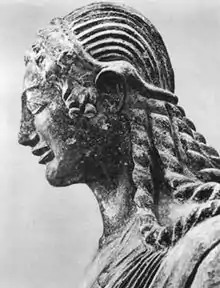Battle of Veii
The Battle of Veii, also known as the Siege of Veii,[1] was a battle involving ancient Rome, approximately dated at 396 BC. The main source about it is Livy's Ab Urbe Condita.
| Battle of Veii | |||||||
|---|---|---|---|---|---|---|---|
| Part of the Roman-Etruscan Wars | |||||||
| |||||||
| Belligerents | |||||||
| Roman Republic | Veii (Etruscan city) | ||||||
| Commanders and leaders | |||||||
| Marcus Furius Camillus | |||||||
The Battle of Veii was a battle between the Romans, who were led by Marcus Furius Camillus, who had been elected dictator, and the Etruscan city of Veii. Veii had engaged the Romans in a long and inconclusive war during which it was often under siege. In order to break the siege once and for all, a tunnel was constructed by the Romans beneath the city. While this occurred, Camillus attacked the city on all sides so as to distract the soldiers and residents of Veii from the tunnel construction by forcing their soldiers to defend the walls. The Romans then emerged from the entrance of the tunnel and their forces quickly overwhelmed Veii.
The Siege
The Romans were led by Marcus Furius Camillus, elected dictator (in the Roman Republic, this was an emergency general rather than a tyrant) after Rome had suffered defeats. Their opponent, the Etruscan city of Veii, was a large city about 16 km (10 miles) from Rome. Veii had engaged the Romans in a long and inconclusive war during which it had often been under siege. One significant legend from this war was the Battle of the Cremera (see: Battle of the Cremera), which propelled the fame of the house of Fabia. In order to break the siege once and for all, a tunnel was reputedly built beneath the city of Veii.
Livy describes the scene with the Veientines holed up in their city, the main Roman force encamped outside and a second force set to attack from within via the tunnel. After Camillus had taken the auspices, he had uttered the following prayer:
Pythian Apollo, guided and inspired by thy will I go forth to destroy the city of Veii, and a tenth part of its spoils I devote to thee. Thee too, Queen Juno, who now dwellest in Veii, I beseech, that thou wouldst follow us, after our victory, to the City which is ours and which will soon be thine, where a temple worthy of thy majesty will receive thee.
Relying on the superior size of the Roman army, Camillus attacked the city on all sides. The intent of Camillus' attack was to distract the Veientines from the mine by forcing their soldiers to defend the walls.
The Veientines wondered "what had happened to make the Romans, after never stirring from their lines for so many days, now run recklessly up to the walls as though struck with sudden frenzy".
As the unsuspecting Veientines rushed to defend their walls from the suddenly frantic Roman army, the Romans entered the tunnel. At this time, the Romans emerged from the entrance of the tunnel inside the temple of Juno and the forces inside and out quickly overwhelmed Veii. After the fighting slackened, Camillus offered to spare the unarmed who began to surrender as the soldiers gathered loot.
The wealth so impressed Camillus that he gave a speech, during which he turned and stumbled, which was seen to be an omen of his later condemnation and the sack of Rome, the latter of which followed a few years later after the Battle of the Allia.
The male population of Veii was slaughtered and the women and children enslaved. The city was subsequently repopulated by Romans. This destruction of the Etruscan stronghold secured Rome's growing place in central Italy.
References
- Michael Grant, The History of Rome, p. 42
Bibliography
- Primary sources
- Livy (1905). . Translated by Canon Roberts – via Wikisource. (print: Book 1 as The Rise of Rome, Oxford University Press, 1998, ISBN 0-19-282296-9)
- Secondary sources
- Grant, Michael (1993). The History of Rome. Faber and Faber. ISBN 0-571-11461-X.
